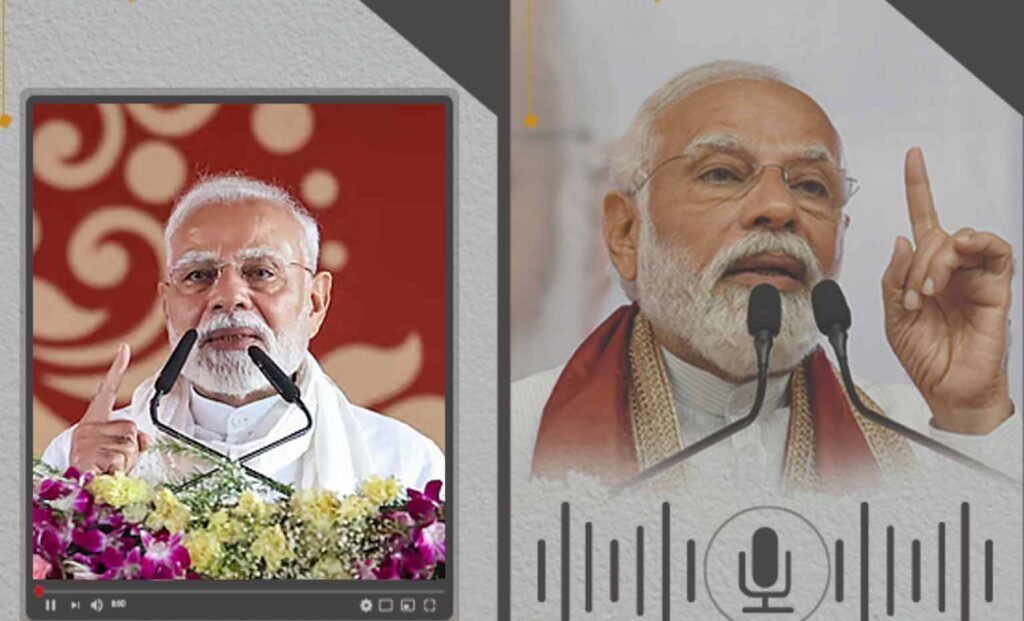As India weighs a massive revamp of its MRP regime, consumers, small shopkeepers, and major retailers await clarity on how ‘fair pricing’ will be enforced. The proposal follows PM Modi’s Varanasi remark and rising global economic pressure.
Modi’s Varanasi Message Signals a Pricing Reset Amid Global Economic Jabs
Political Signals Behind an Economic Reset
In a speech that is now resonating across India’s retail and policy circles, Prime Minister Narendra Modi, while addressing a gathering of shopkeepers in Varanasi, spotlighted a critical flaw in the country’s consumer pricing system. He criticized the widespread practice of artificially inflating Maximum Retail Prices (MRPs) only to offer deceptive discounts—a tactic that, he warned, exploits the poor and undermines public trust in the retail economy.
“Shopkeepers should not cheat poor customers in the name of MRP. There must be fairness in pricing.”
– Prime Minister Narendra Modi, Varanasi, August 2025
This strong stand on pricing ethics was not made in isolation. It came mere days after former U.S. President Donald Trump, during a campaign rally, controversially referred to India as a “dead economy,” claiming that both India and Russia could “take their dead economies down together.” The juxtaposition of these two statements—one disparaging, the other reformist—has reignited a high-stakes national conversation on India’s economic direction, retail governance, and global standing.
“Sell only Swadeshi goods.”
– PM Modi, Varanasi
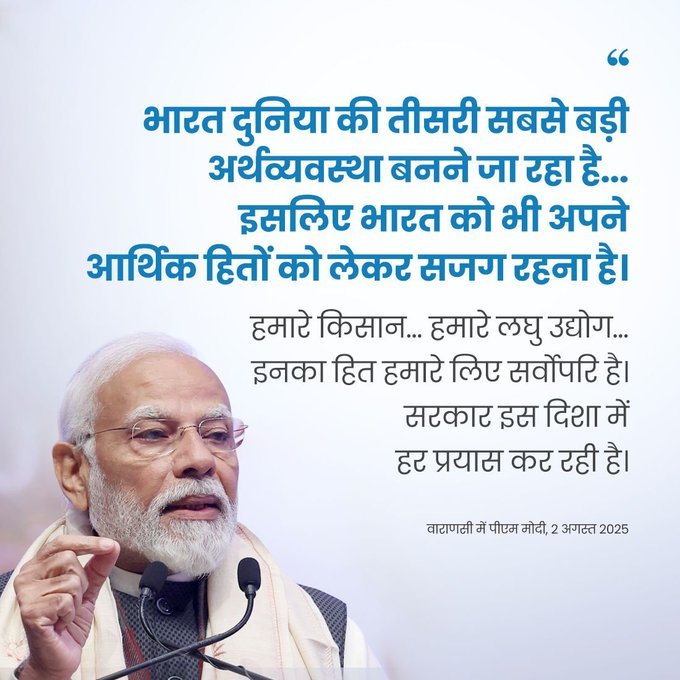
PM Modi’s dual message—urging both ethical retail practices and support for indigenous products—underscores the government’s broader strategy. It reflects a shift from passive consumer protection to proactive economic nationalism. His appeal is a clear signal that India is preparing to redefine its internal market dynamics not only to safeguard consumer rights, but also to assert fiscal credibility in a globally turbulent economic landscape.
PM Modi addressing shopkeepers in Varanasi
PM Modi calling out deceptive MRP discount tactics while urging “Swadeshi” commerce.
The Modi government’s consideration of an MRP overhaul is not a routine policy update. It’s a targeted intervention that blends consumer protection, market transparency, and political messaging. As India positions itself to become the world’s third-largest economy by 2027, such internal reforms are being framed not only as domestic clean-ups but as declarations of resilience against external skepticism.
What Is MRP and Why Is It Important?
The MRP (Maximum Retail Price) is the ceiling price printed on packaged goods that a retailer can legally charge. Introduced to protect consumers, it theoretically ensures pricing transparency. However, over time, it has become a loophole-filled system.
In India, there is no requirement to link the MRP to the cost of production, distribution, or taxes. Sellers can set any MRP they choose, creating a wide margin between actual cost and perceived value. Discounts are then artificially inflated to lure buyers, even when the ‘deal’ is marginal.
Key Provisions Under Current MRP Law:
- Retailers cannot sell a product above the printed MRP.
- Offering discounts below the MRP is legal and common.
- MRP must include all taxes.
Yet, over the years, marketers have gamed the system by:
- Inflating MRP far above the actual market price.
- Offering artificial “70% off” sales.
- Confusing consumers with multi-tier pricing in e-commerce.
Why the Modi Govt Wants an MRP Overhaul
During his Varanasi speech, Modi remarked:
“We cannot allow shopkeepers and sellers to fool the public by inflating prices only to fake discounts. It’s time to bring fairness back to pricing.”
Objectives Behind the Proposed Reform:
- End deceptive discounting practices.
- Ensure pricing transparency.
- Protect consumers from price gouging.
- Create a fair playing field for small traders.
- Address e-commerce anomalies.
What Could the MRP Overhaul Look Like?
Several proposals are under active consideration by the Union Ministry of Consumer Affairs to reform India’s Maximum Retail Price (MRP) system—especially for everyday essentials. The key goal is to ensure that prices better reflect the actual cost structure and to eliminate deceptive pricing practices that give the illusion of large discounts.
According to internal discussions accessed by INA News, the ministry is exploring mechanisms to link MRPs more closely to real production and marketing costs. For commonly used items, this could mean setting “standard cost” benchmarks after consultations with manufacturers, trade bodies, and consumer rights advocates.
The overhaul may require legislative support. Amendments to the Legal Metrology Act and possibly GST regulations are being considered to legally enforce any revised pricing framework.
At the core of these discussions is the need to curb irrational pricing—a practice in which companies artificially inflate MRP and then offer dramatic markdowns that mislead consumers about actual savings. This tactic is common in both e-commerce and large retail chains.
In May 2025, the government began formal consultations with a range of stakeholders, including the Confederation of Indian Industry (CII), consumer protection associations, and tax authorities, signaling the seriousness and institutional scope of the planned reform.
Timeline: Evolution of MRP Laws in India
| Year | Event/Change | Details |
|---|---|---|
| 1976 | MRP Introduced | Under the Standards of Weights and Measures Act |
| 2009 | Legal Metrology Act Passed | Replaced earlier law with a broader consumer protection focus |
| 2011 | Packaged Commodities Rules Notified | Enforced labeling rules and MRP requirement |
| 2017 | GST Implemented | Unified taxation impacted pricing and labeling |
| 2023 | Govt flags deep discounting in e-commerce | Raised concerns over ‘predatory pricing’ |
| 2025 | MRP Overhaul Proposed by Modi Govt | Proposal to redefine and regulate pricing fairness |
Insert image Caption: Timeline of MRP policy development in India since 1976.
The Problem: Fake Discounts and Consumer Deception
Retailers, especially in online platforms, routinely mark up prices before slashing them to claim high discounts. For example, a product priced at Rs 100 may be shown with an MRP of Rs 300 and offered at “70% off” during festive sales. This creates an illusion of savings without genuine benefit.
Consequences of the Current Model:
- Consumers are misled.
- Smaller retailers lose trust.
- Tax authorities face audit difficulties.
- Brand value gets diluted.
The Proposed MRP Reform Model
Though the full draft policy is awaited, early reports and official signals suggest the government is considering the following changes:
1. MRP Linked to Base Price or Input Cost
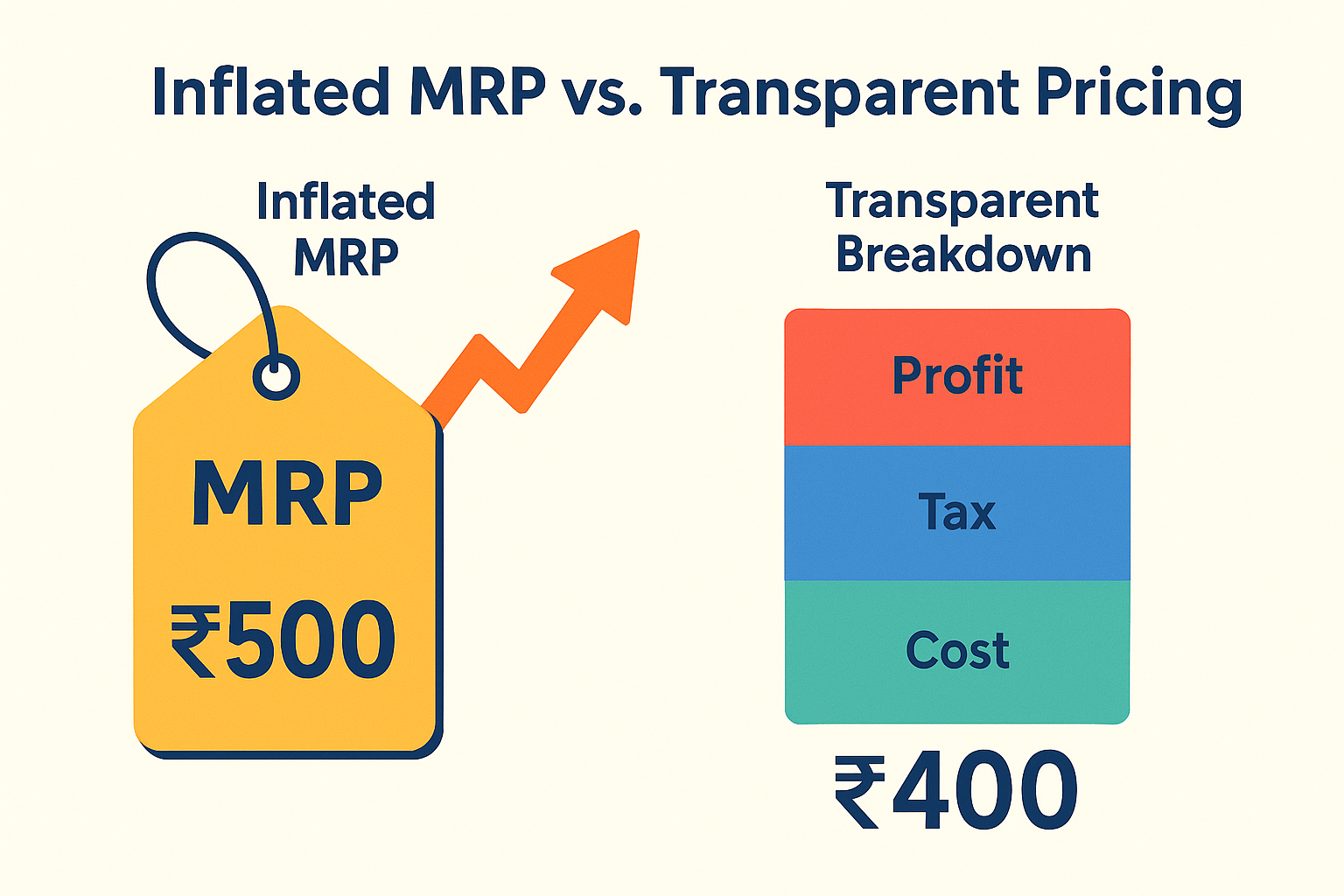
- Sellers may be required to justify the printed MRP with input costs.
- Cap on margin above cost could be introduced.
2. Transparent Price Breakdown
- Labels to display Base Price + Taxes + Margin.
3. Regulating Discounts
- Discounts to be capped or shown relative to base price, not inflated MRP.
4. E-commerce Monitoring
- Platforms like Amazon, Flipkart to be held accountable for deceptive listings.
Comparative Pricing Models: Global Benchmarks
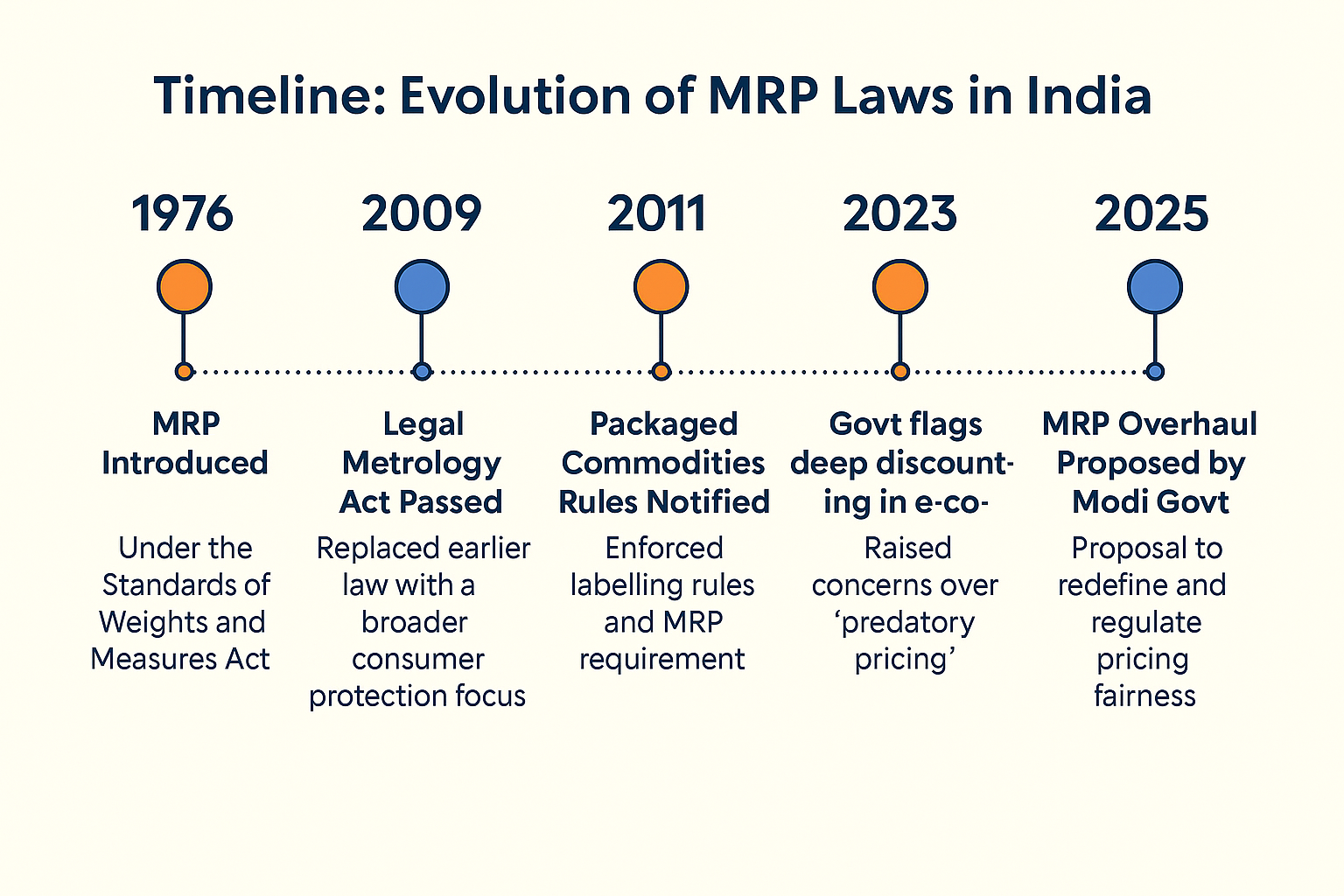
| Country | Pricing Practice | Regulation Style |
| USA | No MRP | Prices set by market, not government |
| UK | Recommended Retail Price (RRP) | Not binding, but monitored |
| France | Price Indication Law | Requires clear base and final prices |
| China | Admin-set price ceilings | Especially in essential commodities |
| India | MRP binding | Proposed: cost-based justified MRP |
Economic Impact: Who Gains, Who Loses?
Potential Winners:
- Consumers: Fairer pricing, no false savings.
- Small retailers: Level playing field against big e-commerce.
- Tax authorities: Better audit trail.
Potential Losers:
- Big retail chains and e-commerce giants with aggressive discount models.
- Brand marketers relying on artificial ‘sales.’
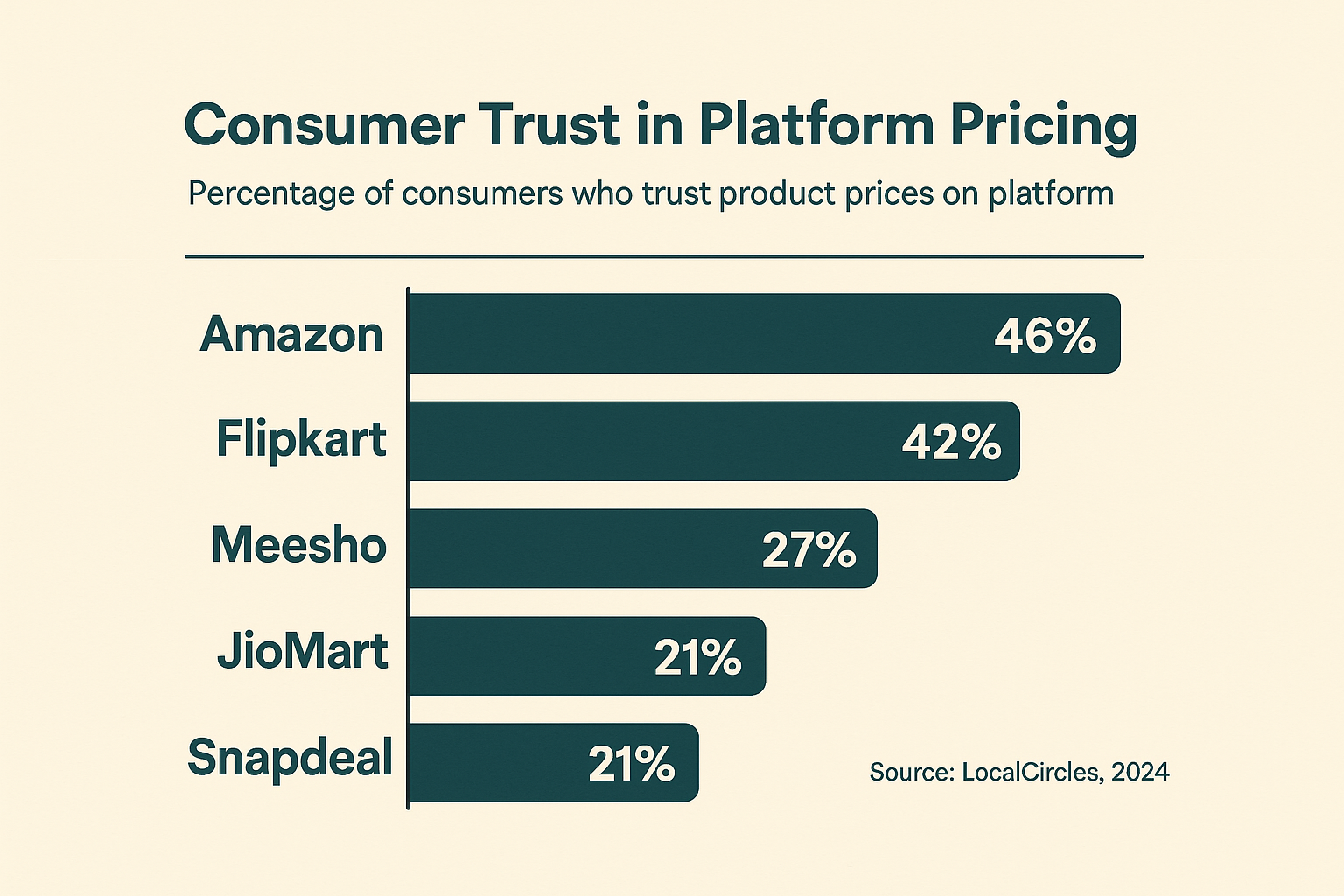
Legal and Regulatory Backing
The overhaul may require amendment of key rules under:
- The Legal Metrology Act, 2009
- The Consumer Protection Act, 2019
- E-commerce Rules (2020, updated 2022)
The Department of Consumer Affairs has begun consultations with:
- Retailer associations
- Legal metrology experts
- E-commerce platforms
Public and Industry Reactions
FICCI and CAIT have cautiously welcomed the move, but sought clarity on how margin caps would be calculated.
Amazon India and Flipkart are reportedly lobbying for a model that preserves promotional flexibility during festivals.
Insert image Caption: Representatives of offline and online retail at the Ministry’s MRP reform consultation meeting. Source: DoCA
Consumer Behaviour: Do Discounts Still Work?
A 2024 Nielsen survey revealed:

| Statement | Agree (%) |
| I trust the MRP printed on labels | 42% |
| Discounts make me buy more | 78% |
| Discounts often feel misleading | 65% |
Insert image Caption: Consumer perception of MRP and discounts in India, based on Nielsen study.
But why this shift, now?
India’s retail landscape has undergone a rapid transformation. A booming consumer market—fueled by online marketplaces, large-format retail chains, and influencer-driven consumption—has created a pricing paradox. Brands routinely inflate MRPs only to slash them later with “50% off” banners, conditioning customers to chase phantom deals rather than value. This strategy has backfired.
Take, for instance, two identical juice sachets—one priced at ₹50, another at ₹150—without any clear quality difference. The disparity is intentional: the higher MRP allows a flashy discount, making the lower tag look like a steal. In truth, it’s a psychological game that erodes trust. With inflation pinching post-pandemic budgets, consumers are becoming more conscious and skeptical. The need for transparent pricing has never been more urgent
More Than Just Pricing—It’s About Trust
The MRP overhaul proposed by the Modi government is far more than a technical correction in labeling norms—it’s a strategic step toward restoring consumer trust, reining in corporate profiteering, and leveling the field between e-commerce giants and small retailers.
This reform attempts to realign India’s retail ecosystem around fair pricing and ethical market behavior, signaling a decisive shift from exploitative consumer practices. By promoting price transparency, the policy could help build long-term trust in retail transactions—a vital factor in sustaining domestic consumption, which forms over 60% of India’s GDP.
However, the success of this reform hinges on execution. If implemented poorly, it could create friction for honest businesses, disrupt supply chains, and trigger temporary inflationary shocks. But if rolled out with clarity, public education, and effective enforcement, it could serve as a landmark policy in consumer rights—the kind that governments are remembered for.
In an election year, this isn’t just economic policy; it’s narrative control. As Donald Trump calls India’s economy “dead,” the Modi government is countering with a populist economic corrective that addresses the ground reality—where millions of Indians still overpay due to MRP loopholes, fake discounts, and price opacity.
Ultimately, this overhaul is a litmus test of governance. Can India modernize its retail laws without over-regulating the market? Can it ensure both business ease and consumer protection? Can political timing align with genuine reform?
Sources:
- PIB Varanasi Speech Archive
- Department of Consumer Affairs (DoCA)
- PRS Legislative Research
- Legal Metrology Act & Amendments
- LocalCircles Consumer Trust Survey (2024)
- Nielsen Consumer Report (2024)


